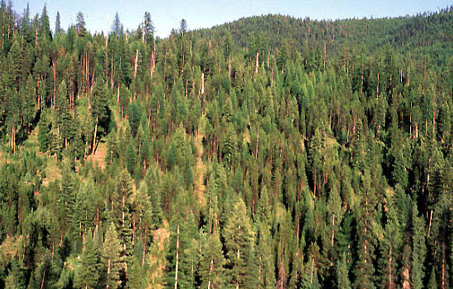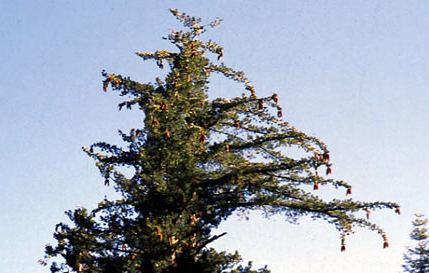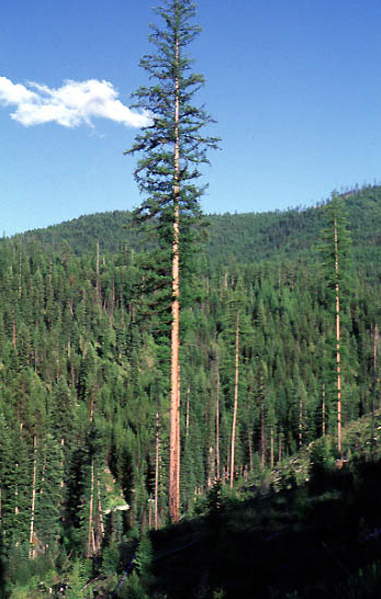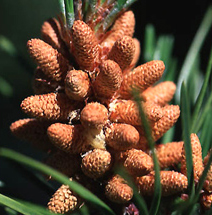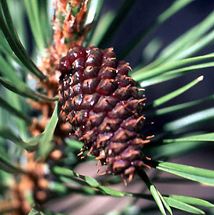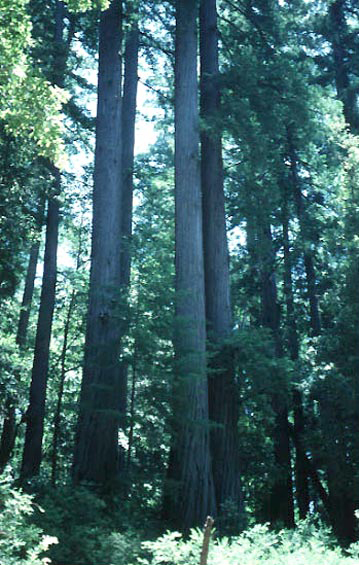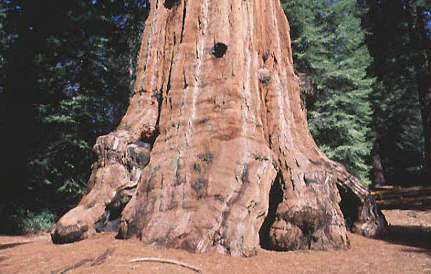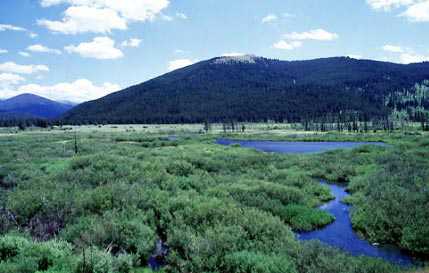Collecting Conifers
On the Pacific coast, the rewards for Douglas were immediate and numerous. Even though first Menzies and then Lewis and Clark had collected plants in the area, they had found only the obvious. Almost every day Douglas was in the field he was finding curious plants that proved to be new to science, and as he traveled up the Columbia River, the novelties became more common. Because he was working for the Royal Horticultural Society, Douglas had to collect flowering and fruiting material, and then often had to return to the area at a different time of the year to gather seeds. Instead of returning to London in 1826, as instructed by Sabine, Douglas decided to stay in America. There were too many new plants yet to be collected.
One of the collections he sent to England with the fall’s home-bound ship was the dried branches and needles of what he would call “Oregon pine,” which today is called Douglas-fir.
The year 1826 found Douglas deep inland, climbing the tall mountains of northeastern Oregon and various peaks in the Cascade Range. Late that year he collected seeds of as many trees, shrubs and flowers as he could find, but if he got cones and seeds of Douglas-fir, he did not mention them. Rain and snow made collecting impossible for the first three months of 1827, and then in late March he and a small party set out to return to England via Hudson’s Bay. Carrying all of his new collections, he and his crew traveled up the Columbia River and across the Rocky Mountains, reaching York Factory on the southwestern shore of the Bay on 28 July.
Douglas spent two frustrating years in England, to which he returned on 15 October 1827. In a sense it was a productive time. He was able to describe the sugar pine, Pinus lambertianus (lam-bert-ee-AYE-nuss; the name means “in honor of Lambert”), the most distinctive discovery that he himself published. As for the other novelties, he left them for others to describe. In late October 1829, Douglas headed back for the Columbia River as the pages of the Transactions of the Royal Horticultural Society and other journals were beginning to fill with the technical descriptions of the numerous new species of flowering plants he had already discovered.
Some eight months later, Douglas’s ship reached the smooth waters of the Columbia, and once again he was collecting in the Pacific Northwest. In a letter dated 11 October 1830, Douglas wrote Hooker that he was sending a special package of six conifers, and apparently all with seeds. One of the six was Douglas-fir. He also indicated he was planning to go to California to collect the following year.
“Some American Pines”
Ponderosa pine, Pinus ponderosa
near Unity, Oregon
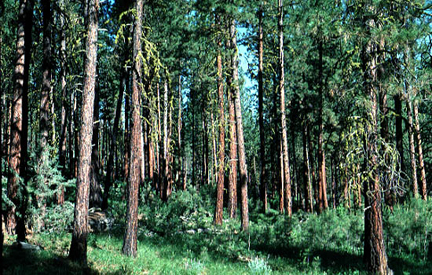
© James L. Reveal.
In 1914, just as the secretary of the Royal Horticultural Society, the Reverend William Wilks, and the Society’s librarian, H. R. Hutchinson, were finishing their editing of the journal kept by David Douglas during his travels in North America, they came upon two hand-written manuscripts by Douglas entitled “Some American Pines.” The two copies were drafts of the same paper, and Wilks and Hutchinson combined the two into a single document that they published (pp. 338–48 in Douglas’s Journal). The editors suggested that the two manuscripts were “about the same date as the other manuscripts from which the rest of this volume has been printed,” or some time between 1823 and 1827. This seems unlikely.
In reviewing the text, some hint of a date begins to appear. First, the manuscript published in 1914 discusses conifers observed by Douglas in the Pacific Northwest and Canada during the years 1823–27. It does not mention any of the new California conifers, most significantly Pinus sabiniana published by Douglas in the Transactions of the Linnaean Society in 1833. It does mention P. lambertiana, the sugar pine that was described by Douglas in 1827, giving the page upon which the name was formally established. This would date the manuscript sometime after Douglas’ return to England on 15 October 1827, and almost certainly after the article was published in mid-December of that year. Equally important is that Abies grandis (Douglas ex D. Don) Lindl., or what Douglas would later call Pinus grandis Douglas ex D. Don, was not included in the manuscript. This species was not found until the year after Douglas left London on 26 October 1829. Finally, Douglas states that he never had it in his power to procure perfect specimens of Pinus monticola, a situation that would be resolved in 1830.
What is curious is this: Why was Pinus lambertiana published by Douglas almost immediately upon his arrival in London, but none of the other species? An answer is not immediately obvious, but the following speculations may be made.
Manuscript for Joseph Sabine
The first species in the manuscript was scheduled to be called Pinus douglasii [=Pseudotsuga menzesii (Mirb.) Franco]. While it is traditional for plants to be named for their discoverer, it is not traditional for one to name a new species for him or her self. Thus, the name Pinus douglasii was credited by Douglas in his manuscript to “Sabine in Trans. Hort. Soc. Vol.” Likewise, the other new species of conifers, P. menziesii [=Picea sitchensis (Bong.) Carr.][1]The nomenclatural summary of these names is as follows: Picea sitchensis (Bong.) Carr., Traité Gén. Conif.: 260. 1855, based on Pinus sitchensis Bong., Mém. Acad. Imp. Sci. … Continue reading, P. nobilis [=Abies procera Rehd.][2]The nomenclatural summary of these names is as follows: Abies procera Rehd., Rhodora 42: 522. 1940, a new name for Abies nobilis (Dougl. ex D. Don) Lindl., Penny Cycl. 1: 30. 1833, nom. illeg., non … Continue reading, P. amabilis [=Abies amabilis Douglas ex J. Forbes][3]The nomenclatural summary of these names is as follows: Abies amabilis Douglas ex J. Forbes Pinet. Woburn.: 125. 1839. (Cultivated specimens grown at Woburn Abbey, England, from seeds gathered by … Continue reading, Pinus monticola Douglas ex D. Don[4]The nomenclatural summary of this name is as follows: Pinus monticola Douglas ex D. Don in Lamb., Descr. Gen. Pinus: 2: unnumbered page between pp. 144 and 145. 1832. Strobus monticola (Douglas ex D. … Continue reading, Pinus ponderosa Douglas ex Laws. & C. Laws.[5]The nomenclatural summary of this name is as follows: Pinus ponderosa Douglas ex C. Lawson in P. Lawson & C. Lawson, Agric. Man.: 354. 1836. (Douglas, Spokane River, Washington, collected in … Continue reading, and Pinus contorta Douglas ex Loud.[6]The nomenclatural summary of this name is as follows: Pinus contorta Douglas ex Loud., Arb. Frut. Brit. 4: 2292. 1838. (Douglas, “on swampy ground near the sea coast; and, abundantly near Cape … Continue reading, were all attributed to Sabine.
It is therefore likely that Douglas prepared the manuscript for the Secretary of the Royal Horticultural Society, Joseph Sabine (1770-1837), with the idea that he would publish the paper. This never happened. However, it is certain that Sabine conveyed the information in the manuscript to David Don (1799-1841), the librarian at The Linnean Society of London, who published several of the names in an unnumbered insert in Lambert’s 1832 third edition of A description of the genus Pinus. Significantly, in the late fall of 1830, Douglas sent a critical set of six specimens of the conifers back to London (they arrived in 1831), and with these, complete descriptions could be drafted. Also, seeds were obtained as well, which were rapidly introduced into cultivation (Pinus ponderosa was already in cultivation).
Six Specimens
Seeds small, pointed at the base, widening upwards, brown, wing pointed, broad and large in proportion to the seed.[7]See volume two of Flora North America for a modern description, illustrations and distribution map of Douglas-fir. [Click on “Online Treatments,” then “Gymnosperms,” then … Continue reading
It appears that Douglas probably drafted his manuscript in 1829 prior to his departure for the Columbia River in October of that year, and indicated to Sabine that he would promptly obtain adequate material to support his belief that each was new to science. It also probably took Douglas some time, in 1828–29, to review the specimens of all of his conifers, in both the herbarium and in the literature, before he could draft his manuscript. As for the new specimens and seeds, these he obtained in 1830, with the result that he had good material of Pinus monticola, and seeds of most of the rest. It is clear that Douglas wrote the manuscript while still in London.
It may also be postulated that Sabine was reluctant to claim authorship of a paper he did not write, and knowing that Don was revising Lambert’s treatment of the pines, took the opportunity to provide him with at least some of Douglas’ names, descriptions and specimens. What caused the delay in the formal publication of some of the new species is unclear. Don described Pinus douglasii, P. menziesii, P. nobilis and P. monticola, but not Douglas’s “P. amabilis,” P. ponderosa or P. contorta. Each of these latter names would appear after 1832 in listings of cultivated plants. Exactly what in the way of specimens was before such authors as John C. Loudon (1783-1843), the noted British horticultural writer, when he proposed his names, is unclear as well. Could he have seen Douglas’ specimens and based his name on this material, or did he see trees in cultivation? The latter now seems likely. As for Charles Lawson (1794-1873), who published P. ponderosa in a book written with his father Peter Lawson (d. 1820), he stated that he saw living material growing in England and made no mention of any herbarium material.
The following is the combined text of the two Douglas manuscripts as published in Appendix VIII of Douglas’ Journal. Editor Reveal has included some additional notes and comments.
Douglas-fir
1. Pinus Douglasii. Foliis solitariis planis subdistichis, strobilis ovatis pendulis, bracteolis exsertis, 3-cuspidatis.[8]This translates to “Needles solitary in approximately a row on each side of the branch, cones ovate, pendulous, bractlets exserted, 3-pointed.” A 3-pointed cone bract is unique to … Continue reading Sabine in Trans. Hort. Soc., Vol.[9]No such paper was published.
Flowers in April and May, fruit ripe in September.[10]Conifers lack flowers, a feature unique to the flowering plants or the angiosperms (Magnoliophyta). The conifers (Pinophyta) have male and female strobuli or cone-like structures that individually … Continue reading
Leaves solitary, flat, entire, imperfectly two-ranked, blunt at the apex, dark shining green above, glaucous underneath, about an inch long. Common filament erect, shorter than the bractea. Another reniform, inflated, destitute of a crest, having instead a blunt, short entire point. Bractea nearly round, concave, densely ciliated or fringed.[11]This section describes the bracts of male strobilus and the stalk (or rachis) that holds of bracts. Female catkin, erect, sessile, oblong or elliptic, one inch long, of a bright pink colour. Bractea lineaer-oblong, ciliate, tricuspidate, persistent, very long.[12]This section describes the immature female strobilus at or just after pollen is released from the male strobilus. This structure eventually becomes the cone. Cone sessile, ovate, pointed, pendulous in clusters at the extremities of the twigs, two to two and a half inches long, one and and a half of an inch in diameter. Scales orbicular, ciliate, slightly notched near the base, entire at the apex, soft and velvety to the touch, fuscous [brownish-green], the bractea of a glossy reddish tint and exserted beyond the scale five-eights of an inch.
Sequoia
The continue with the combined text of the two Douglas manuscripts treating Douglas-fir as published in Appendix VIII of Douglas’ Journal. Some additional notes and comments are added:
Tree remarkably tall, unusually straight, having the pyramidal form peculiar to the Abies tribe of Pines.[13]When Carl Linnaeus established Pinus in 1753, he defined the genus so as to include several genera that are widely accepted today. One of the groups Linnaeus included in Pinus were those now referred … Continue reading The trees which are interspersed in groups or standing solitary in dry upland, thin, gravelly soils or on rocky situations, are thickly clad to the very ground with widespreading [sic] pendent branches, and from the gigantic size which they attain in such places and from the compact habit uniformly preserved they form one of the most striking and truly graceful objects in Nature. Those on the other hand which are in the dense gloomy forests, two-thirds of which are composed of this species, are more than usually straight, the trunks being destitute of branches to the height of 100 to 140 feet, being in many places so close together that they naturally prune themselves, and in the most impenetrable parts where they stand at an average distance of five square feet, they frequently attain a greater height and do not exceed even 18 inches in diameter close to the ground. In such places some arrive at a magnitude exceeded by few if any trees in the world generally 20 or 30 feet apart. The actual measurement of the largest was of the following dimensions: entire length 227 feet, 48 feet in circumference 3 feet above the ground, 7½ feet in circumference 159 feet from the ground.[14]The fact that Douglas was so firm in his belief that this was one of the tallest and largest conifers reflects that this was written before he ventured into California (1830-1832) and saw the coastal … Continue reading
Some few even exceed that girth, but such trees do not carry their proportionate thickness to such a vast height as that above mentioned. Behind Fort George [now Astoria, Oregon], near the confluence of the Columbia River, the old establishment of the Honourable the Hudson’s Bay Company, there stands a stump of this species which measures in circumference 48 feet, 3 feet above the ground, without its bark. The tree was burned down to give place to a more useful vegetable, namely potatos [sic].
On a low estimation the average side may be given at 6 feet diameter, and 160 high. The young trees have a thin, smooth, pale whitish-green bark covered with a profusion of small blisters like P. balsamea or Balm of Gilead Fir [=Abies balsamea (L.) Mill., the balsam fir found east of the Rocky Mountains], which, when broken, yield a limpid oil fluid possessing a fragrant and very peculiar odour, and which, after a few days’ exposure to the action of the atmosphere, acquires a hard brittle consistence like other rosins, assuming a pale amber colour. The bark of the aged trees is rough, rotten, and corky, the pores smaller and containing less rosin, and in the most aged, 4 to 12 inches thick, greatly divided by deep fissures.
Often in the space or vacuity between the bark and the timber of standing dead trees [blank space] is found and may be flayed off in large pieces of several square yards and from its texture and colour might without examination be taken for sheepskin. There is no doubt but this curious species of Fungus hastens the decay of the timber like dry rot in Oak, through perhaps not in the same degree, and, as I have observed it only on erect trees or those dead on the stump, I infer it will not exist in the seasoned wood, consequently cannot detract any merit from it.[15]Douglas had not yet determined the name of the fungus and left a space to insert it.
Wood straight and regular in the grain, fine, heavy, and easily split; the layers or rings of a darker tint, closely resembling the timber of the well-known Larch [probably Larix laricina (Du Roi) K. Koch of eastern North America]. Whether it will prove durable or not remains yet to be known.
If we judge from the quantity of charcoal produced it will not prove so durable as the Larch; the coal is moderately hard, bulky, brown, which might be expected from the great quantity of gaseous matter it contains. What might be the exact age of one of the largest dimensions could not be ascertained, not having the means of preparing a transverse section sufficiently well polished to be able to determine with accuracy the number of annual layers. One tree 14 feet in diameter, counting from the centre, gave 167 rings or layers to within four and three-fourths of an inch of the outside, where they became so thin that they could no longer be exactly ascertained; although with sufficient accuracy upon which to ground a moderate calculation that fifty years added only nine and a quarter inches to the diameter of the trunk.
This is a common tree from Cape Blanco [southern Oregon], situated in 43°, to the Straits of Juan de Fuca [central British Columbia] in 49° North Latitude, abounding in all the mountainous parts of the coast, preferring light, dry, thin, or gravelly soils, on a substratum of sand and clay or on rocky places. A few straggling trees are seen at Cape Mendocino [northern California] in 40° which may be regarded as its most southern range, and likely it will extend much farther north than the habitat above given.[16]Douglas-fir or “coastal Douglas-fir” (Pseudotsuga menziesii var. menziesii occurs from southwestern British Columbia southward to Monterey County, California, and irregularly eastward … Continue reading
Following Lewis & Clark
We conclude the combined text of the two Douglas manuscripts treating Douglas-fir as published in Appendix VIII of Douglas’ Journal. Some additional notes and comments are added:
The mountains of the Grand Rapids of the Columbia, situated in Lat. 46° [Cascade Range], are clothed to the top, some peaks of which exceed 5000 feet above the level of the sea. On the Blue Mountains [northeastern Oregon] of the interior it is also found, and clothes also the subalpine range or base of Mount Hood [Oregon], Mount St. Helens, Mount Baker [both in Washington], and Mount Vancouver [British Columbia] as well as the western base of the Rocky Mountains in 52°7’9 N Lat., 115° N Long. [sic], where it maintains a place, and arrives at a considerable size at an altitude of 9000 feet above the level of the sea, 1000 from the verge of perpetual snow.[17]Given the latitude and longitude (corrected to 115(W), this would be at the eastern base of the Rocky Mountains at Rocky Mountain House, Alberta, Canada, where Douglas arrived on 3 May 1827 on his … Continue reading It is not a little surprising the vast change of climate and of soil experienced between the western and eastern base of the last-mentioned ridge [the Rocky Mountains along the British Columbia and Alberta border] in the same parallel of latitude, and is beautifully exemplified by the growth of the present tree as well as other of the same tribe [e.g., the genus Pinus as defined in the broad sense of Linnaeus]. On the west side it is enormously large [var. menziesii], on the east a low scrubby tree [var. glauca], and without the recesses of the mountains on the same side it ceases to exist. Being an inhabitant of a country nearly in the same parallel of Latitude with Great Britain, where the winter (even judging from the immense covering afforded it by Nature in its bark) is more severe, gives every reason to hope that it is in every respect well calculated to endure our [e.g., English] climate and that it will prove a beautiful acquisition to English Sylva if not an important addition to the number of useful timbers.[18]Today, Douglas-fir is one of the most economically significant forest trees for lumber in the world. It is widely planted as a commercial forest tree in Europe and in scattered regions of Asia and in … Continue reading The wood may be found very useful for a variety of domestic purposes; the young slender ones exceedingly well adapted for making ladders and scaffold poles, not being liable to cast; the larger timber for more important purposes; while at the same time the rosin may be found deserving attention. In the memorable journey of Lewis and Clarke (p. 455)[19]Douglas refers to the 1814 Nicholas Biddle edition of Lewis and Clark’s History of the expedition under the command of Captains Lewis and Clark published in Philadelphia. Douglas may well have … Continue reading, in their interesting account of the timber of that country, we find that they “measured some 42 feet in circumference, at a point beyond the reach of an ordinary man. This trunk for the distance of two hundred feet was destitute of limbs; the tree was perfectly sound, and, at a moderate calculation, its size may be estimated at three hundred feet.” I am most willing to bear testimony to the correctness of their statement as respects the girth of the timber, but after a two years’ residence, during which time I measured any tree that appeared from its magnitude as interesting, I was unable to find any from actual measurement exceedingly the height I have mentioned.[20]Although individual trees of coastal Douglas-fir rarely exceed 90 m (ca 295 feet), there are historical reports of trees reaching 100 m (ca. 328 feet). The Flora of North America, for example, … Continue reading
Douglas-fir in the coastal ranges of northwestern California. I am unable to gather from their description whether the largest mentioned by them can be the same as the present. It would appear not, for in the fifth species mentioned we find that they mention (p. 457): “A thin leaf is inserted in the pith of the cone which overlays the centre of, and extends half an inch beyond, the point of each scale”-an important character in the species now observed, but from what is stated of it generally it belongs to neither.[21]Lewis’ tree “No 5.” was indeed Douglas-fir. The three-point bract on the cone is unique to the genus Pseudotsuga. See Moulton (1990) and Lewis’ entry for 6 February 1806.
—David Douglas
References
Bongard, A. G. H. 1832. Observations sur la végétation de l’île de Sitcha. Mém. Acad. Imp. Sci. Saint-Pétersbourg, sér. 6, Sci. Math. 2: 119-177.
Carrière, E. A. 1867. Traité général des conifèrs. Ed. 2. Published by the author, Paris.
Dietrich, A. G. 1824. Flora der Gegend um Berlin oder Aufzählung und Beschreibung der in der Mittelmark wild wachsenden und angebauten Pflanzen. In 2 parts. G. E. Nauck, Berlin.
Douglas, D. 1827. An account of a new species of Pinus, native of California. Transactions of the Linnean Society 15: 497-500.
Douglas, D. 1833. Description of a new species of the genus Pinus (P. Sabiniana). Transactions of the Linnean Society 16: 747-750.
Flora of North America Editorial Committee (ed.). 1993. Flora of North America north of Mexico. Volume 2. Oxford University Press, New York.
Forbes, J. 1833. Pinetum woburnense, or, a catalogue of coniferous plants, in the collection of the Duke of Bedord, at Worburn Abbey; systematically arranged. Printed by the author, London.[22]Only a hundred copies of this work were published. The Duke of Bedford probably intended the work as a presentation gift to visitors and certain botanists. It was published in May of 1839 and … Continue reading
Hitchcock, C. L., A. Cronquist, M. Ownbey & J. W. Thompson. 1969. Vascular plants of the Pacific Northwest. University of Washington Publication of Biology 17(1).
Lambert, A. B. 1832. A description of the genus Pinus, with directions relative to the cultivation, and remarks on the uses of the several species; also descriptions of many other new species of the family of Coniferae. Ed. 3, with “editio minor” by D. Don. In 2 volumes. Messrs. Weddell, London.[23]The placement of the insert, and the number of pages and plates associated with the unnumbered insert in this volume, varies from copy to copy. In fact it is lacking in some (Renkema & Ardagh … Continue reading
Lawson, P. & C. Lawson. 1836. The Agriculturalist’s Manual : being a description of the agricultural plants cultivated in Europe, including observations respecting those suited to the climate of Great Britain. Published by the authors, London.
Lewis, M. & W. Clark. 1814. History of the expedition under the command of Captains Lewis and Clark, to the sources of the Missouri, thence across the Rocky Mountains and down the River Columbia to the Pacific Ocean, performed during the years 1804-5-6. By order of the government of the United States. Prepared for the press by Paul Allen, Esquire. [Edited by Nicholas Biddle.] 2 vols. Bradford and Inskeep, Philadelphia.
Lindley, J. 1833. Abies. Penny Cycl. 1: 30-32.
Little, E. L., Jr. 1944. Notes on nomenclature in Pinaceae. American Journal of Botany 31: 587-596.
Loudon, J. C. 1838. Arboretum et fruticetum britannicum; or, the trees and shrubs of Britain, native and foreign, hardy and half-hardy, pictorially and botanically delineated, and scientifically and popularly described. 8 vols. Printed by the author, London.[24]This work was actually published in 68 parts from January 1835 until July 1838. I have not been able to determine an exact date for the publication of the scientific names of the conifers attributed … Continue reading
Mirbel, F. B. 1825. Essai sur la distribution géographique des conifères. Mémorie du Muséum d’Histoire Naturelle 13: 28-76.
Morwood, W. 1973. Traveler in a vanished landscape. The life & times of David Douglas, botanical explorer. Clarkson N. Potter Inc., Publisher. New York.
Moulton, G. E. (ed.). 2000. The journals of the Lewis & Clark expedition. Volume 6, The herbarium of the Lewis and Clark expedition. University of Nebraska Press, Lincoln.
Rehder, A. 1940. Abies procera, a new name for A. nobilis Lindl. Rhodora 42: 522-524.
Renkema, H. W. & J. Ardagh. 1930. Aylmer Bourke Lambert and his “Description of the genus Pinus.” Journal of the Linnean Society of London, Botany. 48: 439-465.
Rydberg, P. A. 1917. Flora of the Rocky Mountains and adjacent plains. Published by the author, New York.
Notes
| ↑1 | The nomenclatural summary of these names is as follows: Picea sitchensis (Bong.) Carr., Traité Gén. Conif.: 260. 1855, based on Pinus sitchensis Bong., Mém. Acad. Imp. Sci. Saint-Pétersbourg, sér. 6, Sci. Math. 2: 164. August 1832. (Collector unknown, Sitka, Alaska.) Pinus menziesii Picea menziesii (Douglas ex D. Don) Carr., Traité Gén. Conif.:237. 1855. (Douglas, Arguilar [=Umpqua] River, Oregon, October 1826.) |
|---|---|
| ↑2 | The nomenclatural summary of these names is as follows: Abies procera Rehd., Rhodora 42: 522. 1940, a new name for Abies nobilis (Dougl. ex D. Don) Lindl., Penny Cycl. 1: 30. 1833, nom. illeg., non A. Dietr., Fl. Berlin: 793. 1824, based on Pinus nobilis Douglas ex D. Don in Lamb., Descr. Gen. Pinus: 2: unnumbered page between pp. 144 and 145. 1832. (Douglas, Arguilar [=Umpqua] River, Oregon, October 1826.) Picea nobilis Douglas ex Loud., Arb. Frut. Brit. 4: 2342. 1838. (Cultivated specimens grown in England from seeds gathered by Douglas in Oregon and/or Washington.) |
| ↑3 | The nomenclatural summary of these names is as follows: Abies amabilis Douglas ex J. Forbes Pinet. Woburn.: 125. 1839. (Cultivated specimens grown at Woburn Abbey, England, from seeds gathered by Douglas in Oregon.) Picea amabilis Douglas ex Loud., Arb. Frut. Brit. 4: 2342. 1838. (Cultivated specimens grown in England from seeds gathered by Douglas in Oregon and/or Washington.) The above two names were based on different elements and thus the Forbes name is not a new combination based of the Loudon name. Rather, Forbes likely took the name from a note by William J. Hooker (Comp. Bot. Mag. 2: 93. 1836) who mentioned the name but did not describe the tree. |
| ↑4 | The nomenclatural summary of this name is as follows: Pinus monticola Douglas ex D. Don in Lamb., Descr. Gen. Pinus: 2: unnumbered page between pp. 144 and 145. 1832. Strobus monticola (Douglas ex D. Don) Rydb., Fl. Rocky Mts.: 13, 1060. 1917. (Douglas, mountains near Grand Rapids of the Columbia, Oregon, collected in 1830.) |
| ↑5 | The nomenclatural summary of this name is as follows: Pinus ponderosa Douglas ex C. Lawson in P. Lawson & C. Lawson, Agric. Man.: 354. 1836. (Douglas, Spokane River, Washington, collected in 1826). Neither Lewis and Clark nor Douglas distinguished between ponderosa pine (Pinus ponderosa var. ponderosa) of the Cascade-Sierra Nevada ranges, and the mountain ponderosa pine (Pinus ponderosa var. scopulorum Engelm.) of the Rocky Mountains from southern Canada to northern Mexico. Douglas collected material from the Blue Mountains of Oregon where the scopulorum is the local expression, but most of his material came from locations to the west. |
| ↑6 | The nomenclatural summary of this name is as follows: Pinus contorta Douglas ex Loud., Arb. Frut. Brit. 4: 2292. 1838. (Douglas, “on swampy ground near the sea coast; and, abundantly near Cape Disappointment and Cape Lookout,” Washington, collected in 1830.) Lewis and Clark did not distinguished between the shore pine (Pinus contorta var. contorta) which is restricted to a narrow band along the coast from southern Alaska to northern California, and the much more widespread lodgepole pine (Pinus contorta var. latifolia Engelm.). Douglas confused lodgepole pine with jack pine (Pinus banksiana Lamb.), a more northern and eastern species. |
| ↑7 | See volume two of Flora North America for a modern description, illustrations and distribution map of Douglas-fir. [Click on “Online Treatments,” then “Gymnosperms,” then “Pinaceae.” Scroll down and click on “Pseudotsuga.”] |
| ↑8 | This translates to “Needles solitary in approximately a row on each side of the branch, cones ovate, pendulous, bractlets exserted, 3-pointed.” A 3-pointed cone bract is unique to Pseudotsuga, and allows ready identification of the genus. Although Douglas gives a far more length description in English in the follow paragraphs, the presentation of a Latin diagnosis or description was often added for the benefit of those who did not read English. The rules governing modern botanical nomenclature now requires a Latin diagnosis (a brief statement of how the new plant differs from its near relatives) or a Latin description (Douglas gave a brief description). |
| ↑9 | No such paper was published. |
| ↑10 | Conifers lack flowers, a feature unique to the flowering plants or the angiosperms (Magnoliophyta). The conifers (Pinophyta) have male and female strobuli or cone-like structures that individually bare pollen (male) or ovules (immature seeds, female). This technical distinction was not known to Douglas, or even understood fully until the end of the nineteenth century. Also, the life cycle of Douglas-fir is far more complex that Douglas could ascertain, so that in April and May, pollen is released and in September, the seeds reach a point in their development that they can be removed from the cone. |
| ↑11 | This section describes the bracts of male strobilus and the stalk (or rachis) that holds of bracts. |
| ↑12 | This section describes the immature female strobilus at or just after pollen is released from the male strobilus. This structure eventually becomes the cone. |
| ↑13 | When Carl Linnaeus established Pinus in 1753, he defined the genus so as to include several genera that are widely accepted today. One of the groups Linnaeus included in Pinus were those now referred to the genus Abies. In Douglas’ time, this subgroup within the pine group was often referred to as the “Abies tribe.” Today, the rules of nomenclature state that the term “tribe” applies to a taxonomic group above the rank of genus. The term “section” is applied now to the equivalent taxonomic group below the rank of genus that was implied by Douglas. |
| ↑14 | The fact that Douglas was so firm in his belief that this was one of the tallest and largest conifers reflects that this was written before he ventured into California (1830-1832) and saw the coastal redwood [Sequoia sempervirens (D. Don) Endl.]. That species is the tallest conifer (but not the tallest tree, that being an Australian eucalyptus). It would not be until the 1850s that the bigtree [Sequoiadendron giganteum (Lindl.) Buchholz] would be reported in the scientific literature. That species is the largest (or most massive) conifer (although not the largest plant-like form, that being a fungus). For the difficulties of determining what plants are the tallest, smallest, largest, etc., see Botanical Record-Breakers by Wayne Armstrong of Palomar College in San Marcos, California. |
| ↑15 | Douglas had not yet determined the name of the fungus and left a space to insert it. |
| ↑16 | Douglas-fir or “coastal Douglas-fir” (Pseudotsuga menziesii var. menziesii occurs from southwestern British Columbia southward to Monterey County, California, and irregularly eastward into the Cascade Range of Washington and Oregon, and in the Sierra Nevada of California and extreme west-central Nevada, south to Fresno County, California. Douglas’ suggestion that the species would be further north proved not to be correct; rather, the variety was found much further to the south than he predicted, another indication that the manuscript was prepared prior to Douglas’ visit to California in 1830. |
| ↑17 | Given the latitude and longitude (corrected to 115(W), this would be at the eastern base of the Rocky Mountains at Rocky Mountain House, Alberta, Canada, where Douglas arrived on 3 May 1827 on his trip from the Columbia River to Hudson’s Bay. He was now seeing the Rocky Mountain Douglas-fir (Pseudotsuga menziesii var. glauca (Beiss.) Franco) but did not distinguish between this and the coast variant. The needles of the coastal var. menziesii are yellowish-green on pubescent twigs whereas those of var. glauca are bluish-green to dark green or gray-green on glabrous or pubescent twigs. The most distinctive difference is in the cones. The three-pointed cone bracts of var. menziesii are appressed to the body of a 6-10 cm long mature cone. The bracts of var. glauca are spreading or even reflexed away from the body of a 4-7 cm long mature cone. In addition, the coastal phase is a much taller tree, reaching a height of 90 m or more, while the Rocky Mountain phase rarely is 50 m in height. The overall range of the var. menziesii is from southwestern British Columbia to central California eastward basically into the Cascade and Sierra Nevada ranges. The var. glauca occurs in the Rocky Mountains of central British Columbia and southwestern Alberta southward into Mexico. It also is found in the Cascade Range at higher elevations than var. menziesii such as on the slopes of the volcanic peaks of Mt. Hood, Mt. St. Helens and Mt. Baker, and is the common expression on the Blue Mountains. Like Lewis and Clark before him, Douglas did not distinguish between the two varieties, a distinction that would not be made until both expressions were grown together in European gardens where detailed observations could be made. |
| ↑18 | Today, Douglas-fir is one of the most economically significant forest trees for lumber in the world. It is widely planted as a commercial forest tree in Europe and in scattered regions of Asia and in Australia. Young, immature trees are often favored as Christmas trees, and the Rocky Mountain Douglas-fir is frequently planted as an ornamental. The tree is particularly common in the British Isles where it is often used as a windscreen along the edges of fields, highways and especially airport runways. |
| ↑19 | Douglas refers to the 1814 Nicholas Biddle edition of Lewis and Clark’s History of the expedition under the command of Captains Lewis and Clark published in Philadelphia. Douglas may well have purchased a copy while in Philadelphia in 1823. |
| ↑20 | Although individual trees of coastal Douglas-fir rarely exceed 90 m (ca 295 feet), there are historical reports of trees reaching 100 m (ca. 328 feet). The Flora of North America, for example, indicates the tree rarely reaches 100 m, but Hitchcock et al. (1969) indicate the tree does not exceed 90 m. |
| ↑21 | Lewis’ tree “No 5.” was indeed Douglas-fir. The three-point bract on the cone is unique to the genus Pseudotsuga. See Moulton (1990) and Lewis’ entry for 6 February 1806. |
| ↑22 | Only a hundred copies of this work were published. The Duke of Bedford probably intended the work as a presentation gift to visitors and certain botanists. It was published in May of 1839 and consists of 226 pages and 67 plates. James Forbes (173-1861) was the gardener at Woburn Abbey. Only a few copies exist today. |
| ↑23 | The placement of the insert, and the number of pages and plates associated with the unnumbered insert in this volume, varies from copy to copy. In fact it is lacking in some (Renkema & Ardagh 1930; Little 1944). It is therefore possible the unnumbered pages were distributed after the book was actually published. All attempts to more accurately date this work have failed. For nomenclatural reasons, one now has to assume the third edition of Lambert book was published sometime after Bongard’s paper in August of 1832 but before Rafinesque’s paper was published in (probably) October of 1832. Needless to say, determining when Lambert’s book was actually published is now critical. |
| ↑24 | This work was actually published in 68 parts from January 1835 until July 1838. I have not been able to determine an exact date for the publication of the scientific names of the conifers attributed to Douglas by Loudon. All of the names appeared in volume 4 (pages 2031-2694) and it may well be that 1838 is the correct year. I am not certain if the illustrations (vols. 5-8) appeared with the text or were published at a different time. |
